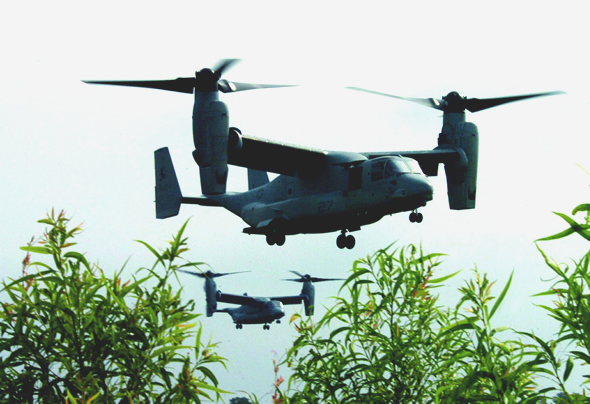
Moving to bolster its special operations and combat search and rescue capabilities, the Israel Air Force (IAF) is re-evaluating the Bell-Boeing V-22 Osprey tilt-rotor aircraft as an optional future vertical lift capability. The IAF evaluated the tilt-rotor plane for several years, until 2009 when the issue was removed from the IAF agenda for the quadrennial procurement plan.
According to Israel’s Jerusalem Post newspaper, the IAF plans to send a delegation of officers to the United States, to meet with Marine Corps representatives and review the V- 22 Osprey’s performance, and adaptability for operations in Israel.

The MV-22 producer, Bell-Boeing leverage the successful rescue of the USAF F-15E aircrew from Libya in March this year, by a pair of U.S. Marine Corps V-22s, aided by AV-8B Harriers, to highlight the versatility and usability of vertical take-off and landing aircraft for Combat Search and Rescue, Special Operations and rapid response operations.
Israel has eyed the V-22 for years, to augment and potentially replace existing heavy lift helicopters, but funding the expensive aircraft was not a priority in past acquisition plans. Although the V-22 cannot entirely replace the IAF upgraded CH-53D (Yasour 2025), particularly for the helicopter’s capability to carry vehicles internally, the Osprey offers much heavier payload capacity (nine tons Vs. the Yasour current 5 tons). The cruising speed of the V-22 is faster than the Sea Stalion (250 vs 170 knots), the Osprey also has much lower acoustic signature, making it more suitable for covert operations.
The MV-22 can transport 24 combat troops, or more than 9 tons of cargo, carried internally and externally (sling load). The Osprey has a mission range exceeding 1,600 km, (compared to 1,000 km of the CH-53D), making it attractive augmenting the IAF operations at very long range.
While the MV-22 could augment the operational capabilities of the IAF, its success is not dependent on its own performance, but on cooperation with other assets to fulfill a mission. The mission in Libya was achieved by a coordinated team of AV-8B Vertical Take-Off and Landing (VTOL) fighter jets securing the area for the Ospreys, using their VTOL capabilities to land and snatch the downed pilot. Operating along with conventional rotary-wing aircraft (such as AH-64 Apache or AH-1 Cobra) would have degraded the Osprey’s advantages, flying along with much slower support aircraft. Alternatively, relying on fighter jets would reduce the mission endurance of the aircraft or require a larger, more complex task force.
Given a positive decision about the Osprey, could therefore lead the IAF to reconsider the F-35B Short Take Off Vertical Landing aircraft, which could be deployed effectively from forward locations, supporting the new assets. The F-35B could also offer advantages in dispersing air combat assets to temporary operational bases, avoiding infrastructure damages at air bases, caused by enemy missile and rocket attacks.
If Israel will eventually decide to buy the Osprey, it is likely the final configuration for the IAF will follow the U.S. Air Force Special Operations variant (CV-22) than the Marine Corms MV-22 version. Israel is apparently interested in a ‘sub size’ squadron of up to ten MV-22s. The Pentagon does not allow export of the Air Forces’ Special Ops equipped CV-22, although Boeing officials say the two aircraft are basically identical, with the CV-22 having more mission equipment that could be applied in country.




















